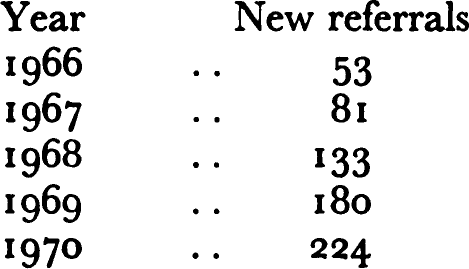Article contents
A Psychiatric Service for the Disturbed Adolescent
Published online by Cambridge University Press: 29 January 2018
Extract
The recognition of the need for psychiatric services for disturbed adolescents led to the opening of the first two adolescent in-patients units in Great Britain in 1949. As a result of community pressures and active encouragement by the Department of Health and Social Security since 1964, an increasing number of units have opened. Although the provision of psychiatric services specially designed to cater for the adolescent has gained momentum only in the past three to five years, the demands of this section of the population is underlined by Rosen et al. (1965) who showed, in an American survey of 750,000 clinic patients seen in 1962, that approximately one-quarter were aged between ten and nineteen years—a number representing 6 · 2 per thousand adolescents of the population served. Similar figures, namely, 6 · 6 per thousand (Kidd et al., 1968), were found in Aberdeen, and 5 · 6 per thousand (Henderson et al., 1967) were found in Edinburgh. Since an adolescent psychiatric service was opened in Edinburgh in 1967, there has been a continual increase in the demand for its services, as follows:

This suggests that the previous figures were an underestimate and that psychiatric disturbance amongst adolescents may be much greater than formerly estimated. Furthermore, such referrals do not indicate the demands for help that Approved Schools and children's homes have made. The authors believe that psychiatric skills are most effectively deployed in these settings if the psychiatrist acts as a consultant to the staff, rather than by assessing and treating individual children (Evans, 1963). Even so, demands have far outstripped the available supply of psychiatric time.
- Type
- Papers
- Information
- Copyright
- Copyright © Royal College of Psychiatrists, 1972
References
- 19
- Cited by



eLetters
No eLetters have been published for this article.